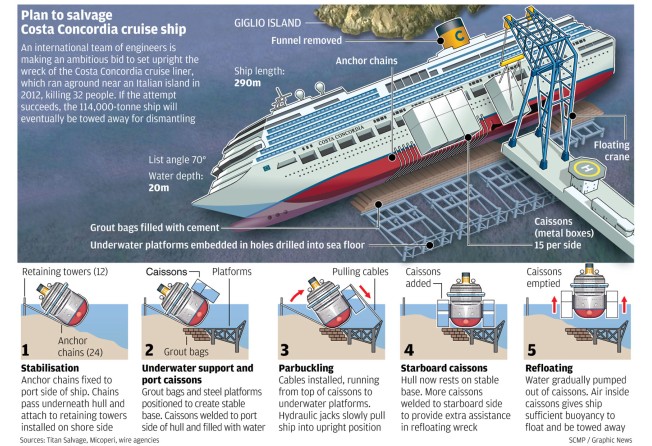US$800m operation to raise Costa Concordia
Risky and complicated task of hauling upright stricken cruise ship begins today, 20 months after it sank off Italian coast leaving 32 dead

All the superlatives apply to the marine salvage operation about to unfold off the Italian island of Giglio - it's the largest, the most expensive and the most complicated. And it's the first of its kind.
In an unprecedented feat of engineering that could make history or fail catastrophically, teams will begin today to hoist upright the wreckage of the cruise ship Costa Concordia.
It has been resting on its side on top of two rocks near an ocean cliff for the last 20 months.
The project's expected price tag is nearly US$800 million.
Called "parbuckling," the job involves a system of 56 enormous cables, 58 pulling machines, 11 multi-storey flotation tanks, six undersea platforms and 1,180 grout bags full of cement.
Weather permitting, the process is scheduled to begin at first light - 16 months after the initial work at the site began and 20 months after the disaster in which 32 people died.
"If it doesn't work, then I don't think anybody can say it's because we did this wrong or that wrong," said Mark Hoddinott, general manager of the London-based International Salvage Union. "They've done everything right. Now they're going into this area where this has never been done with a ship this size before."
video: Unprecedented salvage of Italy cruise ship to start
Florida-based Titan Salvage, one of the two firms awarded the contract for the salvage job, is working with Italian marine contractor Micoperi.
Nick Sloane, Titan's senior salvage master, has been overseeing the operation on Giglio that involves more than 500 workers and continues 24 hours a day, seven days a week.
Officials say the rotation of the ship, a tense balancing act, could take 10 to 12 hours.
While parbuckling as an engineering concept has been historically used to right ships, it has never been tried with one so large. There is no option to start again or change gears if something goes wrong.
First, the ship must be pulled free of the rocks, a difficult task because the hull has wrapped itself around the reef where it rests. Then, the winches will continue to pull the ship until the flotation tanks, called sponsons, reach sea level and can be filled with water.
The water will help push the ship down to the platforms that await on the sea floor.
The operation is a key step in the ultimate removal of the 290-metre vessel, though certainly not the last. Once the ship is upright, the state prosecutor will send in divers to look for two missing victims.
Only after that will the salvage crews be able to assess the damage to the ship's starboard side and determine the best way to move forward. Even if all goes to plan, the ship will probably stay in the environmentally sensitive waters off Giglio's shore until early next summer.
The 114,000-tonne cruise ship, with more than 4,200 people on board, struck rock on the evening of January 13 last year, when captain Francesco Schettino allegedly veered on an unauthorised path too close to land.
The ship took on water and listed on its side. The bodies of 30 passengers and crew were found.
Five Costa employees have reached plea bargains for charges including manslaughter and negligence, but the manslaughter and abandonment trial for Schettino is expected to resume at the end of the month. He could face up to 20 years in prison.